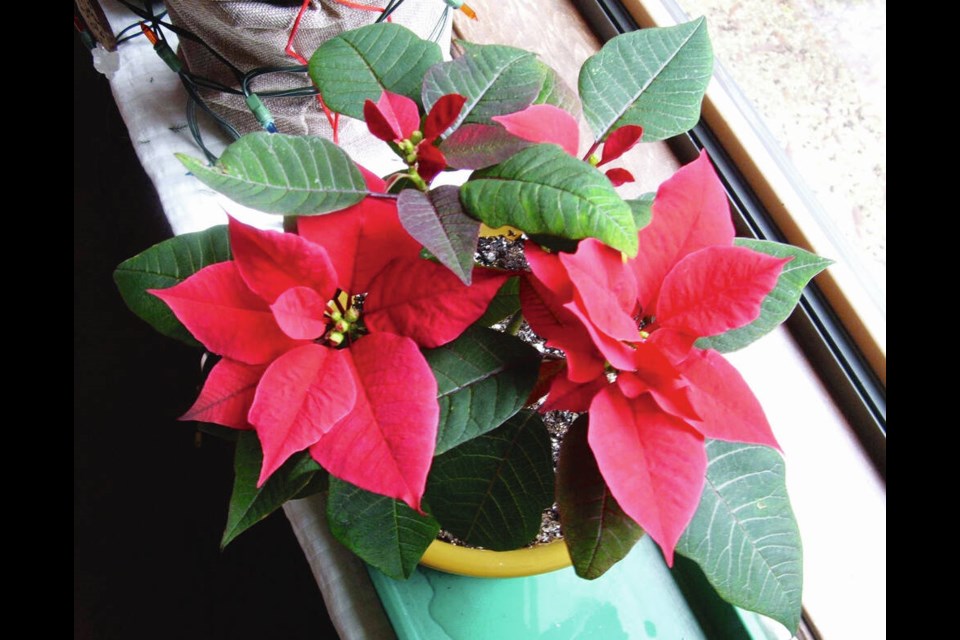Dear Helen: A year ago I bought a tiny, nicely coloured poinsettia. In the spring I removed it from its mini-pot and replanted in a more reasonably sized 13-cm wide pot and set it outside for the summer. When I brought it indoors in September, lacking a space that would provide complete dark between dusk and dawn (for colouring of the bracts), I set it at the window of a room that is not used much in the evenings. Though I did not expect it, some of the bracts developed beautiful red colouring. Can you explain?
H.F.
Not everyone has a suitable site in their homes for a poinsettia to fully colour its bracts (leaf-like structures) following 10 weeks of 10-hour days. The actual flowers are the tiny yellow, berry-like structures at the centre of the bracts.
The easy route to achieving at least some colour is to do what you did: Find a place where lights are not often turned on at night. The degree of colour that develops will depend on the amount of darkness the plant experiences.
This is what I do with my poinsettias. Early in the fall I placed last year’s plant, which had summered outdoors and become full and bushy, at the dark end of the living room window. Of the four leafy stems, two are well coloured and two have just small patches of red. The two well-coloured ones were facing the window, away from any artificial light in the room.
Dear Helen: Our 350-year old Douglas fir tree is constantly dropping needles on the gardens underneath it. I believe the needles decrease the pH level (increase acidity) of the soil. This has negative impacts on the cultivated plants growing underneath, which are not doing well. How can we measure and increase the pH level so these plants can thrive?
N.W.
Fir trees have dropped tremendous numbers of needles this year. My roof and driveway have become covered repeatedly after each cleaning. They are tracked every day into the house.
The needles are acidic and should be removed from garden plots where acidity is not desirable.
You can test a soil’s acidity with test strips or pH meters. I would be very careful, though, about tinkering with the soil under and around the fir tree. These trees can easily live for 500 years and often continue well beyond that. They need a moderately acidic soil, with a pH between 5 and 6. Reducing acidity in the soil to suit the small cultivated plants underneath is probably not a good idea.
Instead, why not plant native species that are a natural part of the Douglas fir forest ecosystem? These include many ferns, notably the wonderfully imposing sword fern, as well as salal, Oregon grape, and vanilla leaf.
If the small ornamental plants currently in the area are not suitable for acidic conditions, move them elsewhere or grow them in pots set under the tree.
Dear Helen: I’ve noticed your mention of rabbits having become a nuisance in your garden this year, and that you are still seeing them in the garden. I’m wondering what they eat to survive during the winter and whether some plants need continued protecting. Is there any repellent that will keep them away from target plants?
C.B.
I’ve covered the beds of salad greens with plastic tunnelling and floating row cover held over wire hoops. I’m sure my visiting bunny (bunnies) would quickly demolish the succulent plants.
In winter, rabbits eat just about any available green plant. Recently I saw a large one on the property of a church, munching on grass and on the needles of a coniferous shrub. They also eat twigs, bark, and buds.
Garlic, onion, marigolds and mint are scents that are often cited as potential rabbit repellents. A fairly thick scattering of partly crushed egg shells protected most of my annual flower transplants in a front bed, though a group of gorgeous, bushy Pink Blush (annual) lavatera were mowed down.
The plant stalks were thick, yet they were chewed through, sending the copious top growth to the ground. Sort of like a logging operation. The severing delivered a full meal, at convenient ground level, to the beast(s).


